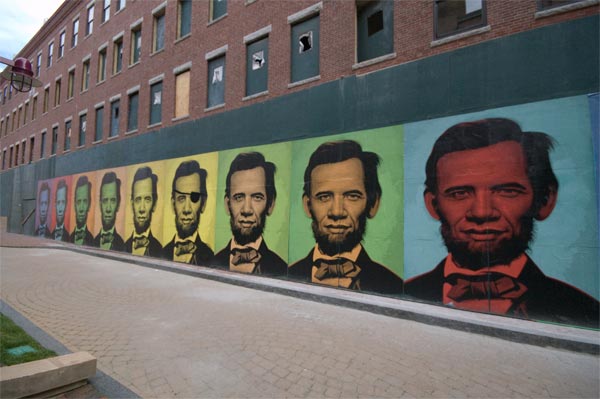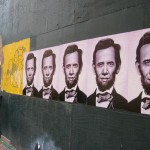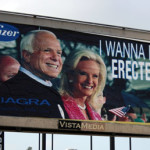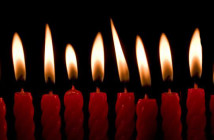ABRAHAM OBAMA @ GALLERY XIV
I guess after years of hearing about Republican candidates as the next incarnation of Reagan, John Wayne, or Jesus, it's nice to see a Democratic candidate get a little action. Thus, Ron English's Abraham Obama is interesting to me as a conversation starter, a provocation, and a Pop-inspired bit of street art.
The piece is a series of large posters, pasted on the construction siding of a building in Boston's South End, along the Thayer Street alleyway and facing the galleries at 450 Harrison. The piece was commissioned by William Kerr of Gallery XIV, in conjunction with the exhibition "a politic". Kerr and English obtained permission to hang the piece on the wall from GTI Properties, the building's owners, who have already allowed other pieces to be hung on the wall, including a series called Pass Go: Collect $200 by Geoff Hargadon. In fact, one of the Hargadon pieces, which were commissioned by Gallery Kayafas, was covered by English's work.
However, after the piece appeared, a minor scandal broke out as fans of English's work started pasting copies of the image around town. I had a conversation with Kerr about the vandalism, and he says that he has no knowledge of who is hanging the posters.
I do love this quote from the Globe, from Joseph Carroll of Bernard Toale Gallery:
"I have seen a few scattered around," Carol(sic) said. "I assumed they were illegal, and I was curious to know why they would do that. Especially since it's not underground; it comes right back to the pieces on the street and the gallery that sponsored it. That didn't seem to be the brightest thing in my mind to do."
One of the many complaintants who called or emailed Gallery XIV, when the illegal posters started appearing, was the Boston Center for the Arts. While it may seem odd for an arts organization, one of the largest non-profits in Boston, to complain about art appearing on their building, the BCA's director of development and marketing Jim Marko offered this (also via the Globe):
"There were no artists suggesting art shouldn't happen," Marko said. "There were facilities people doing their job, which was to keep the public spaces around here clean and proper."
He said had Gallery XIV asked permission to place a poster marketing the exhibit on one of the center's outdoor display boards, it possibly would have been approved.
Ultimately, though, it seems important to ask whether or not the image and installation is interesting, provocative, and thought-provoking, or is it just a bit of easy Pop Art in the street? I think it's a little of both.
Surely, merging the image of any political figure with Lincoln is a complicated gesture, not least because the legacy of Lincoln is very difficult to untangle. He is remembered as one of our greatest presidents, who freed the slaves and won the Civil War. Yet, in his time he was often reviled, called "the great gorilla" by his generals, constantly berated for being too anti-slavery, or not anti-slavery enough. Let's not forget that so many people disagreed with his policies, and his very election as president, that they left to form their own country and spent four years fighting a brutal war in order to avoid having Lincoln as their president.1
However, assuming that most Americans in 2008 look on Lincoln as a great and important figure, which he undoubtedly was and (perhaps more importantly) what his legacy has ultimately meant for this country, merging the image of a political figure with that of Lincoln is certainly meant to implicate the other party as equally great. Abraham Obama melds the rising star candidate from Illinois with a rising star candidate from Illinois. Of course, the 2008 candidate is of the race that belonged to the slave class, that had no rights at all, and whose ancestors were freed by the 1860 candidate (strictly speaking, this isn't true since Obama is not descended from slaves, but the distinction is only marginally relevant, even in 2008). As provocation, this is pretty good stuff. Lincoln as a Republican, Obama the Democrat, both from Illinois, one black, one white, merged as some form of über-statesman.
That said, the context of the piece does somewhat diminish its effect. Hung on a wall facing the arts district of one of the most blue cities in America, in a state celebrating our election of only the second African-American governor in the country's history, the first state to legalize gay marriage, the home state of JFK... talk about preaching to the choir.
This probably explains the fact that complaints regarding the illegal posterings have focussed on vandalism, rather than content. Even though the image raises some interesting topics for discussion, in Massachusetts we know our electoral votes will go to Obama, and English's image is hardly controversial. The same image in a red state might draw far more noise than complaints about vandalism.
Ultimately, Abraham Obama is an interesting image. Ron English has co-opted the look of Pop Art and the methods of street art to support a presidential candidate and start conversations. While the imagery and message are overtly simple, the piece does question the boundaries between propaganda and art, and the nature of perceived greatness of our present political class versus the canonized legacy of the past. Abraham Obama situates itself within a history of political street art that, in recent times, has featured The Guerilla Girls, Robbie Conal and Shepard Fairey (to name a few) and despite the clumsy introduction it is a piece to see.
- Ron English, Abraham Obama, 2008
- Poster versions of Abraham Obama hung in the South End, alongside a piece by Geoff Hargadon.
- A billboard intervention by Ron English






